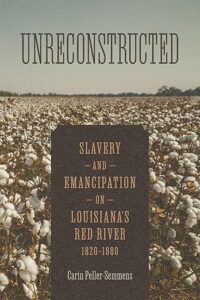Book Review: Unreconstructed: Slavery and Emancipation on Louisiana’s Red River, 1820-1880

 Unreconstructed: Slavery and Emancipation on Louisiana’s Red River, 1820-1880. By Carin Peller-Semmens. Baton Rouge: Louisiana State University Press, 2025. Hardcover, 309 pp. $50.00.
Unreconstructed: Slavery and Emancipation on Louisiana’s Red River, 1820-1880. By Carin Peller-Semmens. Baton Rouge: Louisiana State University Press, 2025. Hardcover, 309 pp. $50.00.
Reviewed By Joseph Ricci
Historian Carin Peller-Semmens documents an often-overlooked chapter of the history of slavery and Reconstruction in northwest Louisiana. Unlike the lower parishes along the Mississippi River, the memory of enslavement, the Civil War, and Reconstruction is decidedly different in the region along the Red River. For starters, while the history of slavery in the lower river parishes is well-known, Peller-Semmens’s work is the first of its kind to fully document the Red River region’s involvement in slavery, emancipation, and Reconstruction. By focusing “on a small corner of the South,” Peller-Semmens delves deep into “our understanding of slavery and emancipation in Louisiana…while generating discussion about the impact of violent white supremacy on African American personhood, citizenship, and identity” (5).
Unreconstructed follows the arc of slavery from the first, early white settlers to the region up to the American Civil War. Of particular interest to those with special enthusiasm for Civil War topics, Peller-Semmens takes readers beyond battles and leaders to a larger, more meaningful understanding of the military campaigns in northwest Louisiana. The region produced and stored food, ammunition, medicine, and clothing, in addition to providing manpower to the Confederacy. Beyond all these matters, Peller-Semmens also stresses the all too often-overlooked aspect of the Confederacy’s reliance on enslaved labor to support the war effort. From fields where raw materials and food were harvested to the defenses around Shreveport and along the Red River, enslaved men and women were integral in the Confederacy’s and slavery’s survival into the last days of the war in Louisiana. To counter manpower shortages as the war progressed, local and national authorities practiced impressment and conscription on the enslaved population. In one notable instance, impressed, enslaved men constructed Fort DeRussy, situated near Marksville. In the effort to build the earthen fort, more than sixty enslaved men died (108-109). Those same men, women, and children, whose toil profited their enslavers and created a vastly wealthy region, soon had a hand in their own emancipation.
As the Emancipation Proclamation eclipsed its one-year mark and the Red River Campaign of 1864 commenced, an “ideological upheaval” took hold of the Confederate forces and “further hardened whites’ hatred and distrust of Blacks,” notes Peller-Semmens (131). Even as the war ended, white soldiers and citizens in the region “remained committed” to the Confederate war effort beyond the surrender at Appomattox. Peller-Semmens brilliantly demonstrates the connective tissue of the end of the war and the violent efforts to restore white supremacy in Louisiana as slavery collapsed. These efforts were not isolated. Rather, the struggle to construct an economically beneficial racial framework of subjugation built on the bones of slavery and the desire to maintain control over the formerly enslaved population was frequently found within efforts to repossess crops, limit mobility, and restrict bodily autonomy or in acts of racial violence exhibited in the massacres at Coushatta and Colfax.
For those interested in the Civil War and Reconstruction, Unreconstructed adds a tremendous insight into the role of slavery and the enslaved on the political, social, and racial legacy in northwest Louisiana. Peller-Semmens adds to Civil War historiography, and Unreconstructed joins works such as Edward Baptist’s The Half Has Never Been Told, Nicholas Lemann’s Redemption: The Last Battle of the Civil War, and pairs well with Justin Nystrom’s New Orleans After the Civil War: Race, Politics, and a New Birth of Freedom. The only shortcoming of Unreconstructed is the limited amount of primary source material Peller-Semmens could access. This is forgivable, though, when one considers the difficulty in documenting the lives of enslaved people across the threshold of slavery to freedom. Peller-Semmens’ work is commendable, and Unreconstructed will be a valuable addition to those seeking to more thoroughly understand the role slavery played in building the economic structures of northwest Louisiana and how it has impacted race relations and social and political constructs for generations.